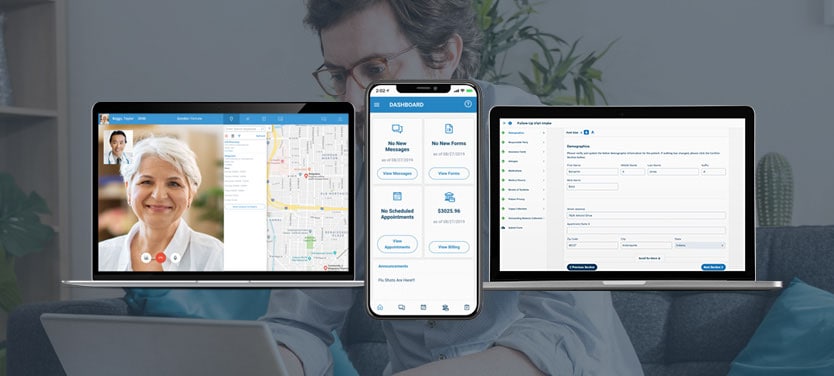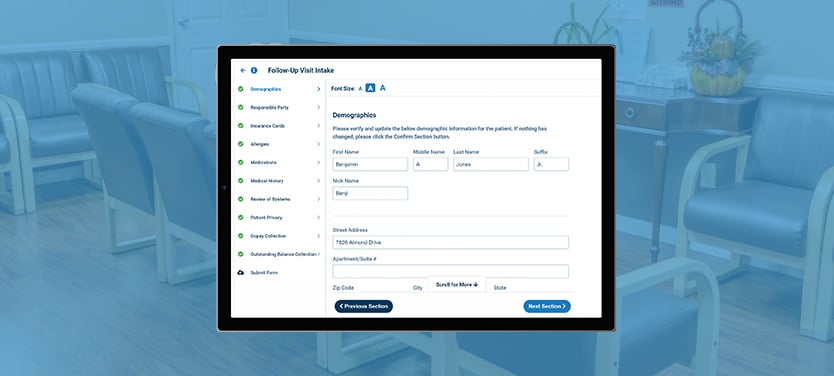Anyone who works in health care knows just how important a patient’s Personal Health Information (PHI) is to a physician’s ability to treat them effectively. Without any patient information, providers risk missing important details regarding patient’s past conditions, allergies, or past treatments. This can lead to poor decision making throughout a patient’s treatment, putting both the patient and physician at risk. The patient intake form was created to ensure that providers have all the information they possibly can before treating a patient. This tool creates peace-of-mind for all parties involved by sewing a safety net that the provider can rely on. While the patient intake form has been around for many years, improvements are being made to better this safety net and improve the way patients engage their providers. The digital patient intake form is helping to minimize risk by helping patients fill these forms out more accurately and efficiently. By making the patient intake form digital, providers are better able to engage their patients as well as improve other areas of the intake process. Here are a few reasons to make the switch to the digital patient intake form.
Improvements Being Make with The Digital Patient Intake Form:
1) Increased Patient Engagement
One of the most discussed phrases in healthcare is patient engagement. The benefits of it are consistently debated among professionals as well as how to increase it and what tools to use improve it. Tools like telehealth and the patient portal are pointed to as pillars in this area and developing patient engagement at any practice. This is true, but providers also need to look toward digitizing their patient intake forms to improve patient engagement as well. The digital patient intake form allows patients to complete their intake information from the appropriateness of their environment. Whether they are at home, on a break at work, or lying in bed, patients complete the form whenever they find themselves with a moment to. Rather than finishing it in haste while they are taking time out of their day to visit with their doctor in person, patients can take their time to answer each question accurately or to the best of their knowledge. This makes sure their form is fully completed while also allowing the patient to reflect on their personal health information and think of questions they might want to ask during their visit. All of these features of the digital patient intake form improve patient engagement.
2) Eliminate Transcription Errors
While this tool improves accuracy by allowing the patient their time to better fill out their patient intake form, this method also increases accuracy by eliminating the need for transcription, and the errors the pile with it. In-person intake involves patients filling out their forms by hand, messy handwriting and all, then handing that form to a provider’s front-office staff who then transcribes that form into their system. This leaves room for a severe number of errors to take place. By allowing a patient to fill out their form by hand, provider’s risk their staff member not being able to transcribe the form accurately. Whether it be misreading the patient’s writing or mistyping the information, the transcription process often leaves the provider with a wealth of incorrectly entered information. The digital patient intake form makes sure that the patient fills out their form more accurately, and then that digital form is transferred directly into the patient’s records, eliminating the transcription process entirely and improving accuracy in a patient’s recorded PHI.
3) Patient Satisfaction
The digital patient intake form creates peace-of-mind for the provider by ensuring that a patient’s PHI is accurate, but this method also creates peace-of-mind and increased satisfaction for the patient. In line with the other tools of patient engagement including telehealth and the patient portal, patients are now able to complete yet another thing without having to make the journey that is going to the doctor’s office. The patient portal makes sure a patient has a convenient way to reach their provider with small questions and concerns as well as keep the patient informed in areas like billing and their PHI. Telehealth helps a patient to visit with their provider from the comfort of their own home, keeping them away from the in-person visit unless necessary. And the digital patient intake form helps patients update their doctors with new information and verify current information more regularly without going into the office. By engaging patient’s better with these tools, providers see improvements in patient satisfaction.
To learn how to better engage your patient and improve peace-of-mind with the digital patient intake form, click here.




